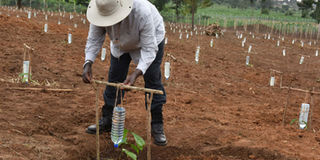Irrigation assurance okay but more needs to be done

President Museveni shows how the drip irrigation method works at one of his demonstration farms last year. PHOTO BY PPU
What you need to know:
The issue: Boosting agriculture
Our view: For a country that is aspiring to attain middle income status by 2020 and upper middle income status by 2040, ensuring food security for the citizens is the right step to take.
Speaking at the 56th Independence anniversary celebrations in Kyotera District on Tuesday, President Museveni said this financial year, government will roll out irrigation projects in at least 14 districts. He reassured Ugandans of government commitment to promote irrigation and ensure food security.
Although the irrigation call has been on for long, it is still good news that the President has not lost focus on what needs to be done to boost agriculture productivity so as to reduce food insecurity.
Agriculture remains the backbone of Uganda’s economy. According to the World Bank collection of development indicators 2017, agriculture employs nearly 70 per cent of Ugandans. Cognisant of this fact, if the government is to succeed in bringing majority of Ugandans out of abject poverty, then making strategic investment in agriculture, including rolling out irrigation, is the way to go.
According to the 2016 Poverty Assessment, the proportion of Ugandans living below the national poverty line declined from 31.1 per cent in 2006 to 19.7 per cent in 2013. However, this can be reduce further if we increase food and cash crop production.
The fact is that food insecurity is a very big challenge, especially to the rural population. For instance, in times of floods or famine, it is the rural population that bears the brunt of the hazards.
However, there are other interventions that the government must embark on to boost food production and improve agriculture generally. For instance, government should deliberately plan to employ agriculture extension services personnel to help farmers on the ground understand and implement better farming practices.
The extension service providers, as was the case in past, should educate farmers on what to plant, when and where, among other issues. The government should also ensure that it distributes to farmers quality inputs, including requisite equipment and quality seeds, among others. It is also critical that government makes it possible for farmers to access favourable and timely credit. With some level of funding, individual farmers will be able to increase their acreage, buy genuine pesticides, and even network among themselves.
For a country that is aspiring to attain middle income status by 2020 and upper middle income status by 2040, ensuring food security for the citizens is the right step to take. And this is in line with Sustainable Development Goal 2, which is to end hunger, achieve food security and improved nutrition as well as promote sustainable agriculture.
Therefore, rolling out irrigation should be just but one of the interventions government must undertake and do it fast.


